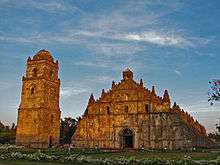Earthquake Baroque
Earthquake Baroque is a style of Baroque architecture found in the Philippines, which suffered destructive earthquakes during the 17th century and 18th century, where large public buildings, such as churches, were rebuilt in a Baroque style during the Spanish Colonial period in the country.[1]

Similar events led to the Pombaline architecture in Lisbon following the 1755 Lisbon earthquake and Sicilian Baroque in Sicily following the 1693 earthquake.
Characteristics
In the Philippines, destruction of earlier churches from frequent earthquakes have made the church proportion lower and wider; side walls were made thicker and heavily buttressed for stability during shaking. The upper structures were made with lighter materials.[2]
Bell towers are usually lower and stouter compared to towers in less seismically active regions of the world.[3] Towers are thicker in the lower levels, progressively narrowing to the topmost level.[2] In some churches of the Philippines, aside from functioning as watchtowers against pirates, some bell towers are detached from the main church building to avoid damage in case of a falling bell tower due to an earthquake.
- San Agustin Church
(1586)  Paoay Church
Paoay Church
(1694).jpg) Binondo Church
Binondo Church
(1596) Miagao Church
Miagao Church
(1731)- Kawit Church
(1624)
See also
References
- "Antigua’s Environs – Antigua, Guatemala". BootsnAll Indie Travel Guide. Retrieved on 2011-07-06.
- "The City of God: Churches, Convents and Monasteries". Discovering Philippines. Retrieved on 2011-07-06.
- Finch, Ric. "Antigue Guatemala-- Monumental City of the Americas". Rutahsa Adventures. Retrieved on 2011-07-06.
External links
- "Earthquake Baroque: Paoay Church in the Ilocos" from the Heritage Conservation Society
- San Pedro de las Huertas, an Earthquake Baroque church in Guatemala
- Earthquake baroque churches of the Philippines